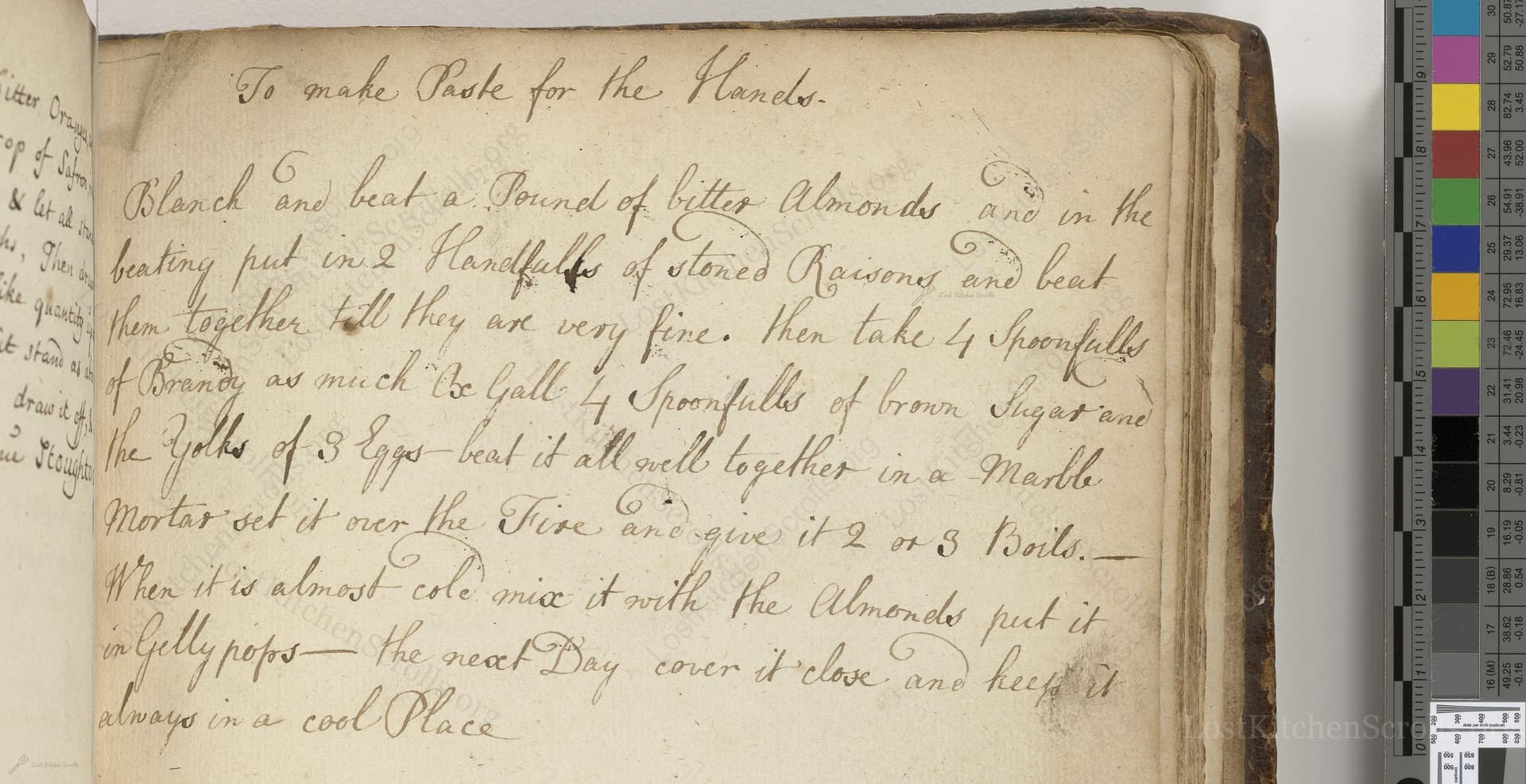To Make Paste For The Hands
From the treasured pages of Receipt book
Unknown Author

To Make Paste For The Hands
"Blanch and beat a Pound of bitter Almonds and in the beating put in 2 Handfulls of stoned Raisones and beat them together till they are very fine. Then take 4 Spoonfulls of Brandy as much as Call 4 Spoonfulls of brown Sugar and the Yolks of 3 Eggs-beat it all well together in a Marble Mortar set it over the Fire and give it 2 or 3 Boils. When it is almost cole mix it with the Almonds put it in Gelly pops- the next Day cover it close and keep it always in a cool Place"
Note on the Original Text
The recipe is written in a typical 17th-century manner: no precise timings or temperatures, and the measurements depend on practical kitchen know-how ('handfulls', 'spoonfulls'). The spelling is not standardized ('raisones' for raisins, 'cole' for cool), and punctuation is sparse. Instructions blend preparation and use, assuming the reader has a good sense of what is 'enough'. There is an expectation of basic culinary skill, such as knowing how to 'blanch' almonds or 'give it two or three boils'.

Title
Receipt book (1670)
You can also click the book image above to peruse the original tome
Writer
Unknown
Era
1670
Publisher
Unknown
Background
A delightful voyage through 17th-century kitchens, this manuscript tempts the senses with timeless recipes, forgotten flavors, and the intrigue of historical culinary craft. Savory secrets and sweet indulgences await within its well-worn pages.
Kindly made available by
Folger Shakespeare Library
This recipe comes from a late 17th-century English household manuscript, a time when personal hygiene and hand care were both practical and fashionable concerns. Instead of shop-bought creams, well-off households crafted their own cosmetics and toiletries using kitchen ingredients. Such pastes for the hands were prized for their emollient qualities, as grinding nuts and mixing them with eggs, sugar, and spirits created a nourishing balm. These recipes also reflect the medical theories of their day, which prized almonds for 'softening' properties, and often blurred the line between cookery and medicinal care.

Originally, this paste would have been made with a marble mortar and pestle, prized for its smooth grinding ability. Hands, wooden spoons, and a small pan or pipkin set over a gentle fire would be used for mixing and heating. The final product was kept in 'gelly pots'—small, covered jars or pots—stored in a cool larder or cupboard, since refrigeration was not available. Modern cooks can use a food processor, double boiler, and airtight glass jar.
Prep Time
20 mins
Cook Time
10 mins
Servings
8
We've done our best to adapt this historical recipe for modern kitchens, but some details may still need refinement. We warmly welcome feedback from fellow cooks and culinary historians — your insights support the entire community!
Ingredients
- 1 pound bitter almonds (or 1 pound sweet almonds plus a few drops of almond extract, if bitter unavailable)
- 5 ounces pitted raisins
- 4 tablespoons (1/4 cup) brandy
- 4 tablespoons (1/4 cup) brown sugar
- 3 egg yolks
Instructions
- To make a fragrant and moisturizing paste for your hands, start by blanching and peeling 1 pound of bitter almonds (if unavailable, use sweet almonds with a few drops of almond extract for bitterness).
- Place the almonds in a food processor (or mortar and pestle, for authenticity), and add 2 handfuls (about 5 ounces) of pitted raisins.
- Grind everything together until a very fine paste forms.
- In a small bowl, mix 4 tablespoons (1/4 cup) of brandy, 4 tablespoons (1/4 cup) of brown sugar, and the yolks of 3 eggs.
- Beat this mixture well.
- Combine it with the nut-raisin paste.
- Place the combined paste in a heatproof bowl and gently heat it over a simmering water bath, stirring, just until it thickens slightly (give it "2 or 3 boils").
- Let the mixture cool until just warm, then knead or mix again thoroughly.
- Spread the finished paste into small pots or jars.
- Cover tightly and keep in a cool place.
- Use a small amount to soften and fragrance the hands as needed.
Estimated Calories
170 per serving
Cooking Estimates
It takes about 20 minutes to prepare the ingredients and another 10 minutes to cook the paste gently. Each serving contains around 170 calories, and this recipe makes about 8 small pots or servings.
As noted above, we have made our best effort to translate and adapt this historical recipe for modern kitchens, taking into account ingredients nowadays, cooking techniques, measurements, and so on. However, historical recipes often contain assumptions that require interpretation.
We'd love for anyone to help improve these adaptations. Community contributions are highly welcome. If you have suggestions, corrections, or cooking tips based on your experience with this recipe, please share them below.
Join the Discussion
Rate This Recipe
Dietary Preference
Culinary Technique
Occasions

Den Bockfisch In Einer Fleisch Suppen Zu Kochen
This recipe hails from a German manuscript cookbook compiled in 1696, a time whe...

Die Grieß Nudlen Zumachen
This recipe comes from a rather mysterious manuscript cookbook, penned anonymous...

Ein Boudain
This recipe comes from an anonymous German-language manuscript cookbook from 169...

Ein Gesaltzen Citroni
This recipe, dating from 1696, comes from an extensive anonymous German cookbook...
Browse our complete collection of time-honored recipes



